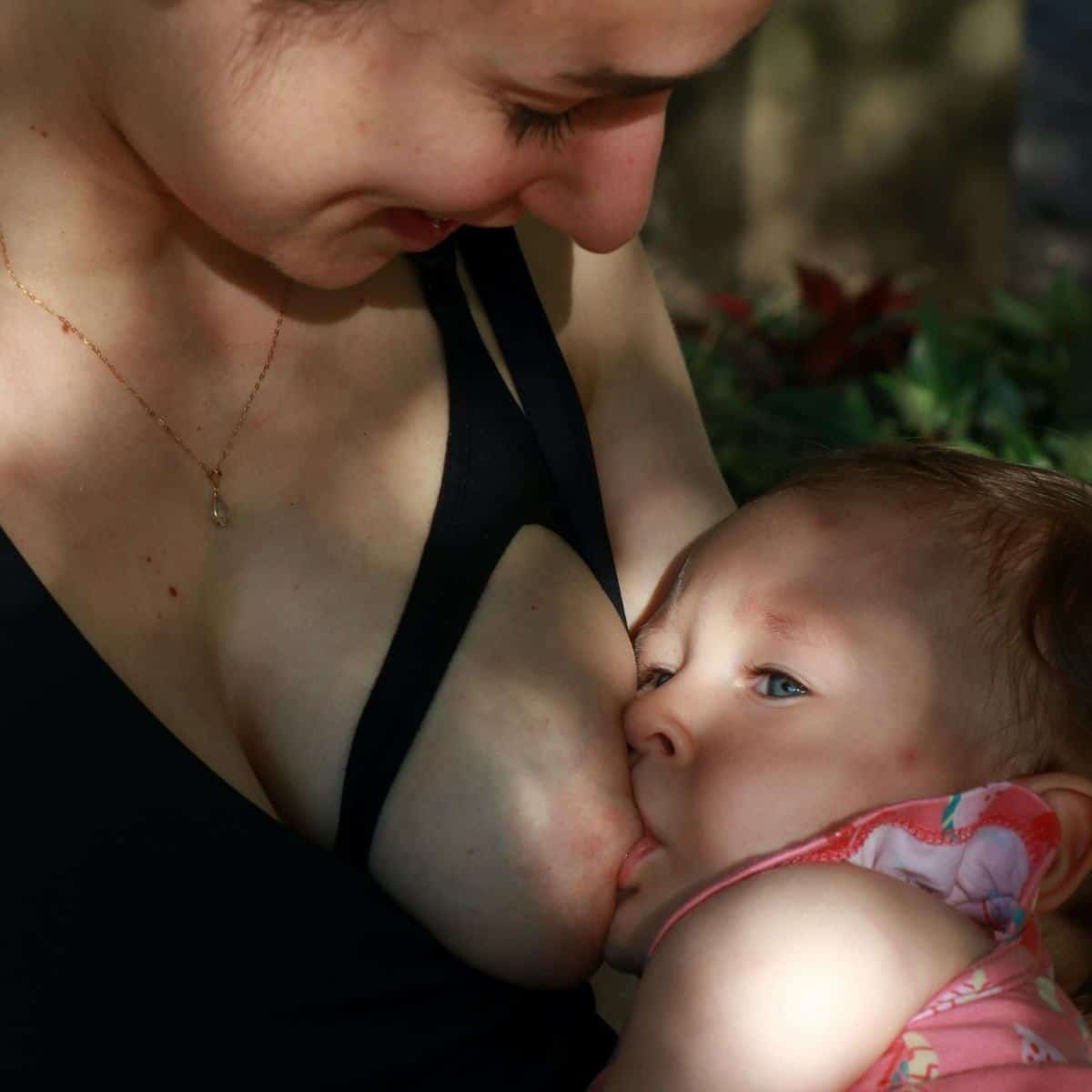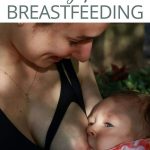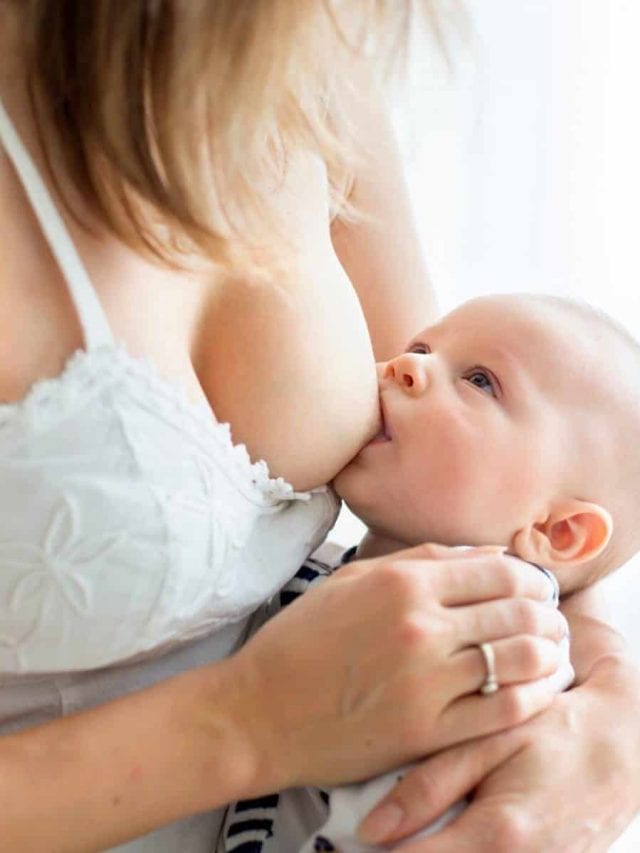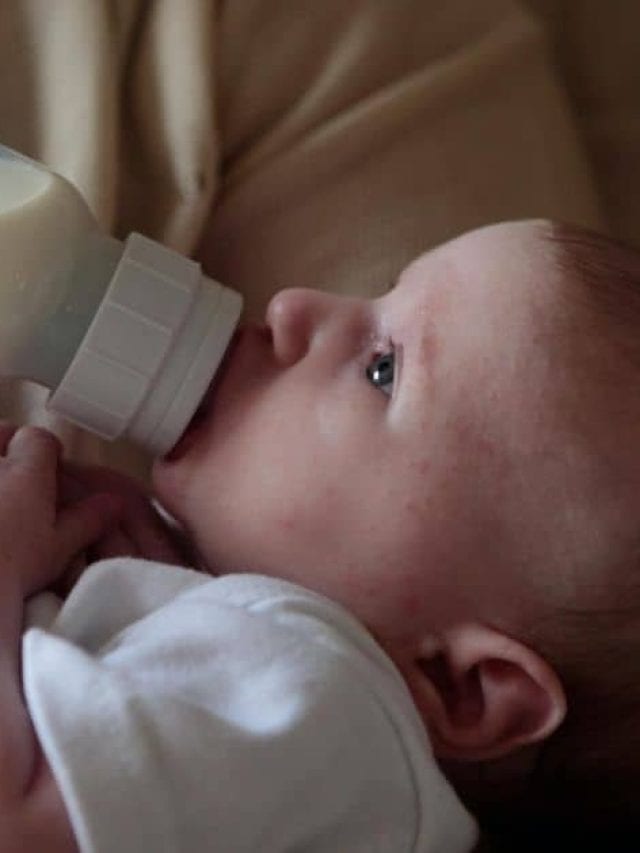That moment you first wonder if you need to be a dairy free breastfeeding mom–it’s pretty scary. Your baby is showing physical symptoms that suggest you may need to eliminate dairy, and it’s overwhelming to imagine feeding a new baby and making a drastic dietary change.
You may be seeing scary things like mucus or blood in their diapers; they may be spitting up a lot; and you’re simultaneously grossed out, exhausted, and afraid.
I’ve been there, mama, and I can tell you that these symptoms are often signs of babies with a milk protein allergy. Dairy free breastfeeding is a common solution because milk protein passes through breast milk to baby.
If you’re seeing these symptoms and want to go on an elimination diet, or if your child’s pediatrician has suggested your baby may have a food allergy to cow’s milk, it may be time for a diary free diet for breastfeeding.
Still unsure if baby’s symptoms are really allergic reactions? Contact your pediatrician for help before starting any kind of elimination diet.
If your pediatrician agrees that you may need to cut out milk proteins in your diet, we’ve got you covered with all the signs of a cow’s milk protein allergy and tips for starting a dairy free breastfeeding diet.

This site contains affiliate links, meaning that we earn a small commission for purchases made through our site. We only recommend products we personally use, love, or have thoroughly vetted.
- What you need to know about Dairy Free Breastfeeding
- Dairy Free Diet for Breastfeeding: Milk Protein Intolerance
- Symptoms of dairy allergy in a breastfed baby
- Dairy Free Diet Breastfeeding tips
- Dairy Free Breastfeeding Diet is not for me: What should I do?
- Breastfeeding Elimination Diet FAQS
- Other Breastfeeding Articles
- Other Favorites from Undefining Motherhood
What you need to know about Dairy Free Breastfeeding
So many moms are confused by even the thought of dairy free breastfeeding. Here are the most commonly asked questions and the most straightforward answeres we can give you.
A mom who is dairy free breastfeeding has removed all milk proteins from her diet so she can produce breast milk that is healthy for her baby with a milk protein allergy.
Most moms begin a diet that eliminates dairy because their child is exhibiting signs of a milk protein allergy. Symptoms include blood or mucus in baby’s stool, excess vomiting, gagging, colic, or skin rashes. Parents start dairy free breastfeeding at the recommendation of baby’s pediatrician.
If you suspect your baby might have a milk protein allergy, contact their pediatrician. A doctor will conduct a physical exam, in addition to asking you about your family’s history with allergies. Your baby might undergo a stool test, blood test, skin test, and/or oral challenge test at the doctor’s office.
According to the Children’s Hospital of Philadelphia, milk proteins will disappear from mom’s system within 1-2 weeks. Some sources say it may take up to 21 days.
Dairy Free Diet for Breastfeeding: Milk Protein Intolerance
When my oldest kiddo was about 2 weeks old, I opened up a diaper to see an alarming amount of pink and red-streaked mucus. To say I was scared was an understatement!
Thanks to Doctor Google, followed by a call into the pediatrician’s office, I was able to boil it down to a probable milk soy protein intolerance.
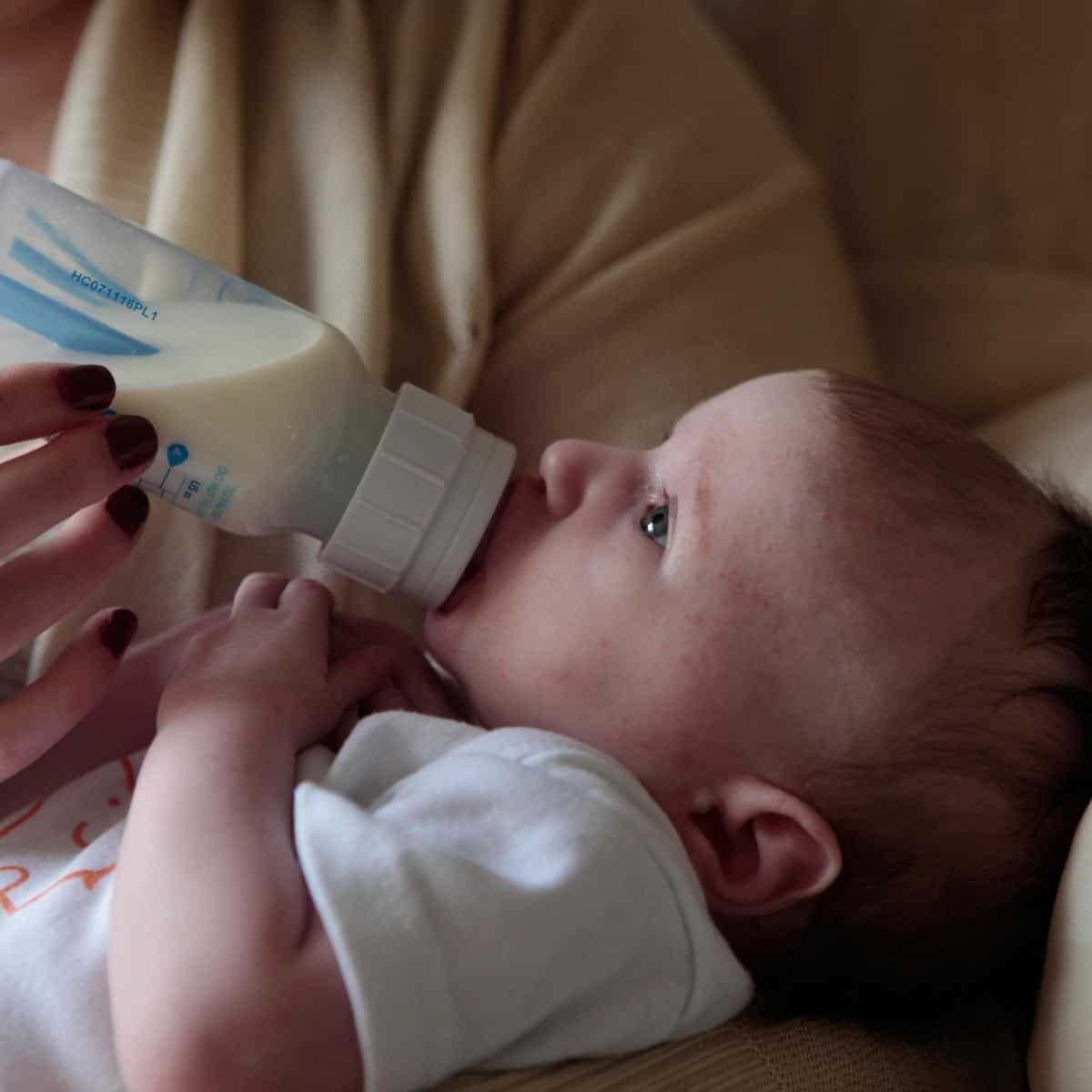
The fix? Switch to hypoallergenic formula or transition to a dairy free diet for breastfeeding. Since my son had pretty severe colic, I was willing to try just about anything.
As a lifelong lover of all dairy products, this was like a punch in the gut!
But we were young and hypoallergenic formula was expensive, so I was hoping to nurse as long as possible. This led me to a full year of soy and dairy free breastfeeding.
Symptoms of dairy allergy in a breastfed baby
Before you make any drastic moves, know that a true dairy allergy isn’t that common. In fact, only 2.5% of children younger than 3 have a true dairy allergy.
Many babies and children do have a dairy intolerance, though, and the good news is that most grow out of it!
There are many ways to pinpoint a dairy intolerance, but the only sure way is by bringing a diaper to the doctor and having it tested.
Here are some common signs you might need to talk to your pediatrician about dairy free breastfeeding:
- Mucus-y diapers. Basically mixed in with the “normal” poo, you’ll see what looks like little boogers in it. Gross, I know.
- Blood in diapers. Nothing crazy – if it’s a lot of blood, please go to a doctor immediately. A dairy intolerance usually shows up as a streaks of red and pink mixed in with the previously mentioned mucus.
- Spitting up. And not happy spitting. We’re talking LOTS of spit up and uncomfortable, crying babies. The true sign of “too much” spit up is your baby is not gaining weight at a rate your pediatrician is comfortable with.
- Excessive gas. Is baby crying from lots of gas even though you burp well? It could be gas caused by a milk intolerance.
- Upset for long periods of time. This isn’t the best test because excessive crying could be the result of SO many issues, but if your baby cries for hours at a time regularly and has other symptoms of milk intolerance, talk to your pediatrician.
- Skin allergies. Finally, a big sign of a milk allergy is skin allergies like eczema. If you can deduce that excessive eczema isn’t from laundry detergents or scented soaps and lotions, this could be a good reason to try dairy free breastfeeding.
Dairy Free Diet Breastfeeding tips
Okay, so you and baby’s pediatrician have decided that yes, you need to try a dairy free diet for baby.
But where on earth do you start with this daunting task?! You have to eliminate a lot of common foods to make your breast milk totally dairy free! I’ve got you covered with my best tips for removing cow’s milk from your diet.
(1) Figure out what dairy actually is
The first step to starting dairy free breastfeeding is to know what exactly you need to cut out. Diary has so many names that it can be confusing.
And just FYI: eggs are NOT dairy, which is a common misconception. Do your research and learn what you really need to cut out.
Next, ask your pediatrician what the intolerance is. For example, if the intolerance is lactose, you’ll need to consume lactose-free foods.
My son was intolerant to the proteins in milk, called casein, so I had to avoid every source of milk.
Note: It’s a common misconception that people who are allergic to milk are all lactose intolerant, but the two are very different, and understanding your baby’s problem is key.
Lactose is is a milk sugar, while casein is a milk protein.
A casein allergy occurs when someone’s immune system overreacts to the milk protein, while someone who is lactose intolerant is missing the enzyme lactase, which allows us to break down the milk sugar lactose.
Common hidden sources of dairy, according to the Children’s Hospital of Philadelphia, include artificial butter flavor, ghee, pudding, caramel candy, chocolate, lunch meat, hot dogs, sausages, and margarine.
(2) Learn to read labels
This goes hand in hand with learning what dairy is, but companies use many different words for cows milk.
Even if there isn’t a “this product contains milk” on the label, read the ingredients. The word “casein” is code for milk products. Food labeling laws require the word “milk” to appear in the ingredients list on the product label, but to be safe, we recommend learning about all common foods to avoid on labels.
We recommend this printable source for great information about reading labels to figure out which products contain cow’s milk.
(3) Ask questions
As a born people pleaser, this was so hard for me, so eating out just didn’t happen too often!
But if you’re eating out while dairy free breastfeeding, ask about what’s in your food.
Since I had to avoid both soy AND milk, this was super hard and important. Servers and restaurants are generally great at being helpful, especially if you can explain that your child is intolerant.
To help your servers help you, be very clear about WHAT you need to avoid and WHY.
I found specificity helped a ton. Saying “I can’t eat XYZ because it will make my baby very sick,” was a great way to bring attention to my issue.
Finally, if somewhere you want to eat is NOT willing or accommodating to you, stop going there. Seriously, that’s just rude.
(4) Give it time
When, in a few days, your baby still is miserable, you’ll probably want to give up and take a huge bite out of a wheel of cheese. Trust me, I know the feeling.
But know it can take up to 14 days for all dairy to leave your system! THEN give it another 14 days to make sure it’s out of THEIR system.
If, in that month, you don’t see ANY improvement to the way your baby reacts to your milk, talk to your pediatrician about your options.This is how you know it’s working–when you see improvement in symptoms after 3-4 weeks.
I ALWAYS recommend that moms trying out dairy free breastfeeding also cut out soy for the first 4 weeks. This way, you’re not stuck going through the first month with little improvement and having to wait another month to test out removing soy.
Soy and milk proteins interact with the body very similarly, so many babies who require dairy free milk also need soy free milk.
Finally, know that once you get the bulk of milk and soy out of your system, single slip ups tend to take less time to leave the body.
So while it might take a month to “get clean” at first, I found a couple of days were all that was needed after a slip up. Thank goodness.
(5) Find substitutions
This is the most important thing to do to be successful with removing milk from your diet.
There are SO many options now for dairy free products. There’s almond milk, coconut milk, oat milk, and more! Just be sure your baby doesn’t have additional allergies that would require you to avoid other types of foods.
Try out multiple coffee creamers (we love Califia & Nutpods unless your baby also has a nut allergy), dairy free ice creams, and dairy free cheeses to find one you like.
I actually used it as an opportunity to learn how to make things myself, like bread and tortillas. (Most have at least soy in them, if not also milk. This is why you need to always read the labels!)
I loved the Spectrum line of butter and shortening for baking.
(6) Subscribe to Thrive Market
Admittedly, this is directly connected to finding substitutions. But Thrive Market lets you shop by diet, so you can tell it up front that you need all ingredients to be dairy free and soy free.
Also, finding good dairy free and soy free alternatives often means buying specialty products. Some may be hard to find in your local stores, depending on where you live. But even if you have access to them, they’re pricey.
Thrive Market requires an up-front subscription, but then cuts your grocery bill nearly in half on all these specialty products.
And with this link, you get 25% off your first order and a free gift when you join.
Dairy Free Breastfeeding Diet is not for me: What should I do?
First off, lose the guilt. Going dairy free when you’re used to it is HARD. SO HARD. Especially if you love all things diary.
If it’s just not working, there’s a few things you can do – first: TALK TO YOUR CHILD’S PEDIATRICIAN.
I cannot stress this enough.
They might give you suggestions about alternatives, like testing to make sure it’s a milk intolerance and not something else.
You can also try a dairy free formula. Yes, they can be more expensive, but see if your pediatrician has samples and if your insurance covers it.
At the end of the day, you have to make sure that your child is healthy and happy, but that you are also healthy and happy.
Give dairy free breastfeeding a shot, and if it doesn’t work out, do your homework on other options. You can do this, mama!
Breastfeeding Elimination Diet FAQS
It can take up to 14 days for all dairy to leave your system! THEN give it another 14 days to make sure it’s out of THEIR system.
This was the first question I had when I started dairy free breastfeeding. Generally speaking, milk intolerance in babies rarely lasts longer than a year.
My pediatrician had me eat totally clean and dairy free for a year before introducing directly via solids, and my son was fine after that.
It can take up to a month for a baby’s symptoms to improve after you eliminate dairy from your diet. If you are still not seeing improvement in your baby, you should follow up with your doctor, as you might have more than one allergy on your hands.
Eliminating dairy from your diet can work while breastfeeding! You will want to keep a journal of the foods you eat and what you’ve eliminated in order to make sure that you are truly eliminating all dairy. Remember: dairy can be sneaky, so research and learning to read food labels is important.
The most common food sensitivities in breastfed babies are: dairy, eggs, nuts, soy, peanuts, and wheat. You’ll want to follow a careful elimination diet usually starting with dairy if your baby exhibits symptoms of an allergy. Always consult your pediatrician first before beginning an elimination diet.
A dairy-free diet while breastfeeding means that you will need to eliminate all dairy or dairy-derived ingredients and milk proteins (including casein or caseinates, lactose, whey products, and more). The good news is that there are so many options now for dairy-free products, including: almond milk, coconut milk (and creamer), oat milk, and more. There are also many kinds of dairy-free options for your favorites like ice cream and cheese.
What products and advice do you have for dairy free breastfeeding? We’d love to hear from you!
Other Breastfeeding Articles
- How to increase breastmilk supply
- Dealing with breastmilk oversupply
- Exclusively pumping tips
- Best nursing pajamas
- Tips for choosing a breast pump

